Shangri-La Tibetan village enjoys the holidays with harmony
By Huang Yiran in Cizhong and Shan Jie in Beijing Source:Global Times Published: 2019/12/25 19:43:40
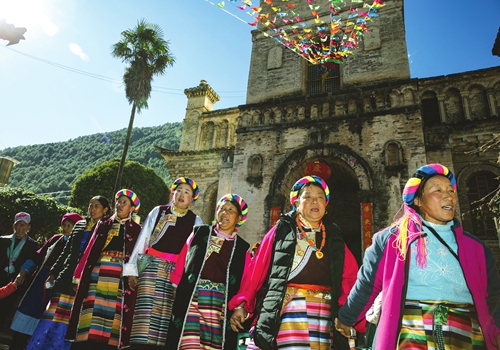
Villagers dance in front of the church to celebrate Christmas on Wednesday in Cizhong, Diqing Tibetan Autonomous Prefecture, Southwest China's Yunnan Province. Photo: Li Hao/GT
Donning colorful silky Tibetan garments with woolen capes and sitting beside each other in a small church, some villagers wait for their annual holy mass on Christmas Eve.
The Cizhong Church, built in Gothic style in the early 1900s, sits in a remote village surrounded by mountains in Diqing Tibetan Autonomous Prefecture, Southwest China's Yunnan Province.
Cizhong is also known as the "small Shangri-La," the mysterious heaven on earth.
"Today is your birthday, I beg your redemption," sang the Christians in Putonghua.
The melody is known by most Chinese people. The original song was composed in the 1980s to celebrate China's national day, but was modified by Chinese Christians as a classic carol. There are usually 70 or 80 people who attend the service on Sundays. On Christmas, about 300 attended.
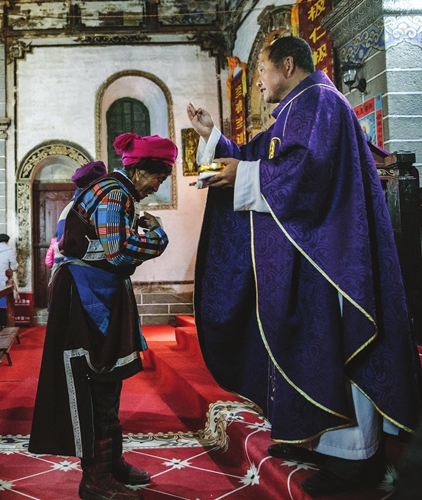
A Christian woman and a priest during the holy mass on Tuesday. Photo: Li Hao/GT
At 9:00 pm, after the warm-up singing, the mass began. The ritual proceeded like it would in any other part of the world. Worshippers sang carols. Sacraments and sermons were performed. Mass is conducted in both Putonghua and Tibetan languages.Priest Ma Yongping put a baby Jesus statue in a small cradle. It all ends near midnight. The next morning, villagers bring cakes to the church and distribute them. Christians then donate their money to the church.
Harmonious village
The Cizhong village, 2,258 meters above sea level, is a multicultural community with three religions and seven ethnic groups.
Among its 1,331 residents, 40 percent are Catholics, 35 percent believe in Buddhism and 5 percent are of Dongba, an ancient religion of the Naxi people. Its seven ethnic groups include the Tibet, Han, Lisu, Naxi, Bai, Nu and Yi ethnicities.
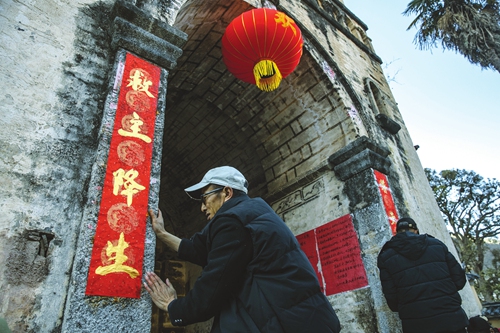
A man posts a couplet outside the church before Christmas. Photo: Li Hao/GT
All the different ethnic and religious groups of Cizhong live a harmonious life together in nature. It is common for a household there to have family members of different backgrounds.In Cizhong, people celebrate festivals together. At weddings, everybody comes to enjoy wine and dance to show their blessings.
"What impresses me the most is the harmony between different ethnic groups and different religions," Yao Fei, village priest told the Global Times.
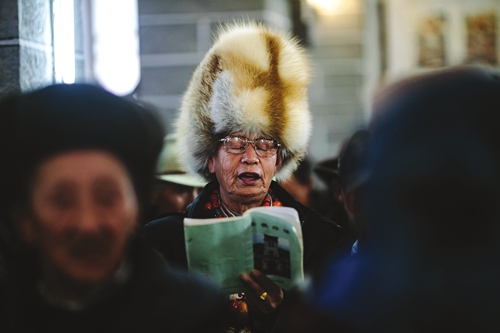
A man chants in the Cizhong church. Photo: Li Hao/GT
"When a Buddhism believer was sick, Catholics would offer to help. I am not a local, but the villagers are all nice to me and respect me a lot."The atmosphere in Cizhong has won it the honor of being a model village in Yunnan Province.
Priest's story
This is Yao's 12th Christmas in Cizhong.
Born and raised in North China's Inner Mongolia Autonomous Region, Yao became a Catholic under the influence of his parents. He graduated from the National Seminary of Catholic Church in 1991 after six years of study and became a full-time priest.
Yao said that people of different ethnic groups in Cizhong speak the same language, Tibetan. Customs such as weddings are the same. Only when it comes to religion are they different.
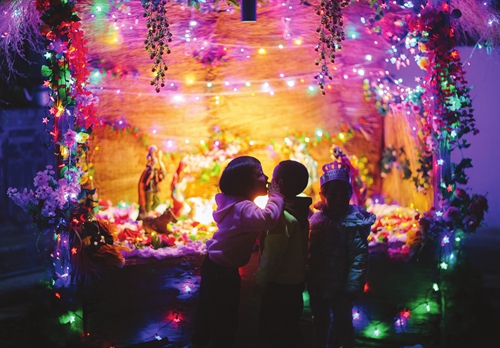
Children look at Christmas statues in Cizhong village. Photo: Li Hao/GT
Religious ceremonies and rituals have been localized in Cizhong. Even though Christian practices follow the order of the church, many ethnic customs are retained and well respected. Yao can speak Latin. He still uses Latin in religious ceremonies.Yao said that the first several years in Cizhong were very difficult. "I did not understand their language at all… But then I realized how important the language is, and now I could speak some basic Tibetan." He said there was no electricity in the first two years.
"In recent years every family is getting better. The policies are good to the ethnic minorities. Also, the hydroelectric station was built here. The road is good," Yao said.
"Even though Cizhong is a small place, it is very famous and important. In a Tibetan region, a Church that could be built and kept for more than 100 years is very precious," he said.
Developing tourism
The small Shangri-La of Cizhong, far away from modern world, is a dream destination for many tourists.
The village that used to rely on farming is now tapping into its tourism potential. Meanwhile, with favorable policies, residents have been lifted out of poverty in the past years.
In 2018, the average income reached 10,000 yuan ($1,431) per villager, according to Cizhong government.
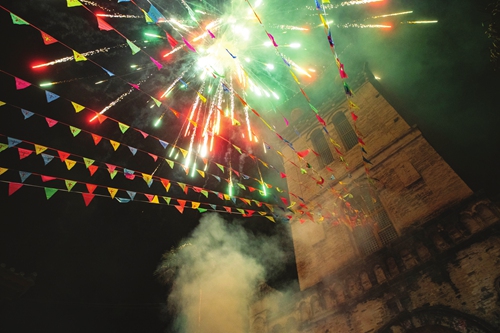
Fireworks are set off to celebrate Christmas outside the Cizhong church on Tuesday. Photo: Li Hao/GT
The Cizhong Church was built by French preachers from 1909 to 1921. In 1987, it was labeled as a provincial-level cultural relic by the Yunnan government and was put under protection. In 2006, it was listed as a national relic.
Nowadays, tourism has become the main income for Cizhong villagers. There are 25 hotels and inns in the village and more than 20 restaurants and agritainment attractions.
More than 400 residents work in the wine making sector in Cizhong. Cizhong people also have a tradition of making wine along with the traditional Tibetan barley wine. French preachers brought the skill and grapes. Rose Honey, the grape species used to make wine in Cizhong, has been extinct in Bordeaux, its hometown, according to a statement from the Cizhong village government.
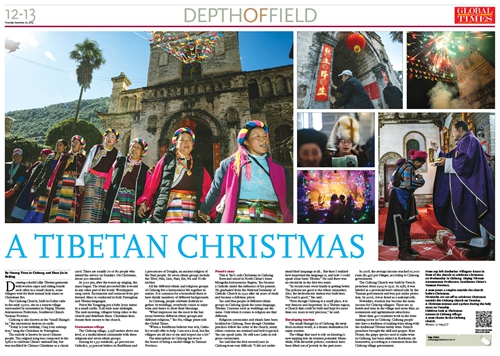
Newspaper headline: A Tibetan Christmas